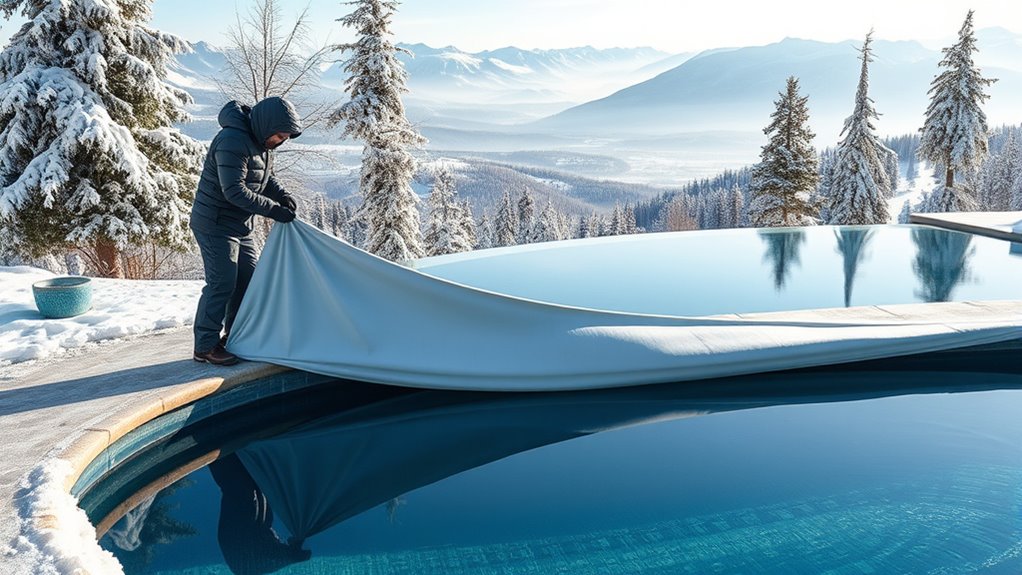To winterize your infinity pool without damage, start by choosing a sturdy, well-fitted cover—solid for snow and debris, or mesh for drainage. Balance the chemicals carefully, ensuring pH, alkalinity, and calcium hardness are within recommended ranges, and shock the water to prevent algae growth. Secure the cover tightly and regularly clear snow and debris to prevent stress. Proper chemical balance and cover security help protect your pool during the cold months—discover more tips to keep your pool in top shape.
Key Takeaways
- Choose a secure, properly fitted cover (solid or mesh) suited for your climate, and ensure it is securely anchored.
- Balance pool chemicals, maintaining pH 7.2–7.6, alkalinity 80–120 ppm, and calcium hardness 200–400 ppm before closing.
- Shock the pool with chlorine or non-chlorine shock, then run the pump to circulate chemicals thoroughly.
- Regularly remove water, debris, and snow from the cover to reduce stress and prevent damage from weight.
- Incorporate winterizing algaecide if needed, and avoid draining the pool completely to prevent surface stress or structural damage.

As winter approaches, it is essential to prepare your infinity pool to withstand the cold months and prevent costly damage. Properly winterizing your pool involves more than just shutting off the equipment; it requires careful planning and execution. One of the most important steps is selecting the right pool cover options. You want a cover that provides a secure barrier against debris, snow, and ice while allowing for easy installation and removal. Solid safety covers are popular because they stay taut and prevent debris from entering the water, reducing the need for frequent cleaning. Mesh covers are another option, as they allow water to drain through while keeping larger debris out. Whichever you choose, make sure it fits snugly to prevent wind from displacing it or letting debris settle inside. Securing the cover properly is essential to avoid damage caused by ice expansion or heavy snowfall.
Equally important is maintaining the chemical balance of your pool before winterizing. Proper chemical balance minimizes algae growth, inhibits corrosion, and preserves the integrity of your pool’s surfaces and equipment during the off-season. Before closing the pool, test the pH, alkalinity, and calcium hardness levels. Aim for a pH between 7.2 and 7.6, alkalinity around 80-120 ppm, and calcium hardness of 200-400 ppm. Adjust these levels accordingly using pool chemicals. Shock the water with a chlorine or non-chlorine shock treatment to eliminate bacteria and organic matter. This step is crucial because it prevents algae blooms and bacterial growth during the months your pool remains unused. After shocking, run your pump for a few hours to circulate the chemicals thoroughly, then add a winterizing algaecide if recommended.
When it comes to pool cover options, consider the climate in your area. If heavy snowfall is common, a solid cover might be better suited to withstand the weight. If you experience frequent storms, a mesh cover combined with a secondary snow guard could be advantageous. Once your cover is in place, make sure it is anchored securely and that water and debris are regularly removed from the top to prevent excessive weight and potential damage. Proper chemical balance maintenance before covering your pool is equally important; it helps prevent corrosion and staining and keeps your pool’s surfaces in good condition throughout the winter.
Frequently Asked Questions
Can I Winterize My Infinity Pool Myself or Hire a Professional?
You can winterize your infinity pool yourself if you’re comfortable with DIY maintenance, but hiring a professional service guarantees it’s done correctly and safely. A professional has the expertise to prevent damage, especially with complex features like infinity edges. If you lack experience, it’s better to invest in professional service to avoid costly repairs later. Weigh your skills and comfort level to decide whether to do it yourself or call in experts.
What Is the Best Time of Year to Winterize an Infinity Pool?
You should winterize your infinity pool in late fall, ideally before temperatures drop consistently below freezing. First, select an appropriate pool cover to protect it during the off-season. Then, adjust the chemical balance to prevent algae growth and corrosion. This timing guarantees you can perform a thorough cleaning, drain water properly, and apply antifreeze if needed, helping you avoid damage and keep your pool in top shape for spring.
How Often Should I Check My Pool During the Winter Months?
You can’t afford to let things slip through the cracks—regular checks are essential. During winter, inspect your pool every 2-4 weeks, focusing on pool cover maintenance and water level monitoring. Keep an eye out for debris or ice buildup, and make sure the cover stays secure. This way, you prevent damage and maintain your pool’s condition, saving yourself headaches when it’s time to reopen. Consistency is key!
Are There Specific Chemicals Recommended for Winter Pool Care?
You should use winter-specific chemicals to maintain proper chemical balance and prevent algae growth. Regularly test your water and adjust the pH with pH adjusters to keep it between 7.2 and 7.6. Add a winterizing pool chemical kit that includes algaecide, stabilizer, and a sanitizer designed for cold temperatures. These steps help protect your infinity pool from damage during winter, ensuring it’s ready for use when spring arrives.
Will Winterizing Affect the Pool’s Warranty or Future Repairs?
Winterizing your infinity pool typically won’t affect your pool warranty or future repairs if you follow proper procedures. Proper maintenance and winterization steps help prevent damage, ensuring your warranty remains valid. Be sure to use recommended chemicals and seasonal covers. If you skip essential steps or cause damage during winterizing, it might impact your coverage. Always consult your manufacturer’s guidelines to protect your investment and keep your pool in top condition for future repairs.
Conclusion
Now that you know how to winterize your infinity pool properly, you’ll guarantee it stays pristine and damage-free through the cold months. Remember, neglecting this step is like leaving Pandora’s box open—disaster waiting to happen. So, take your time, follow the steps carefully, and treat your pool like a precious treasure. If you do, come spring, you’ll be swimming in a flawless oasis just like in the good ol’ days of swimming pools in the Roaring Twenties.









